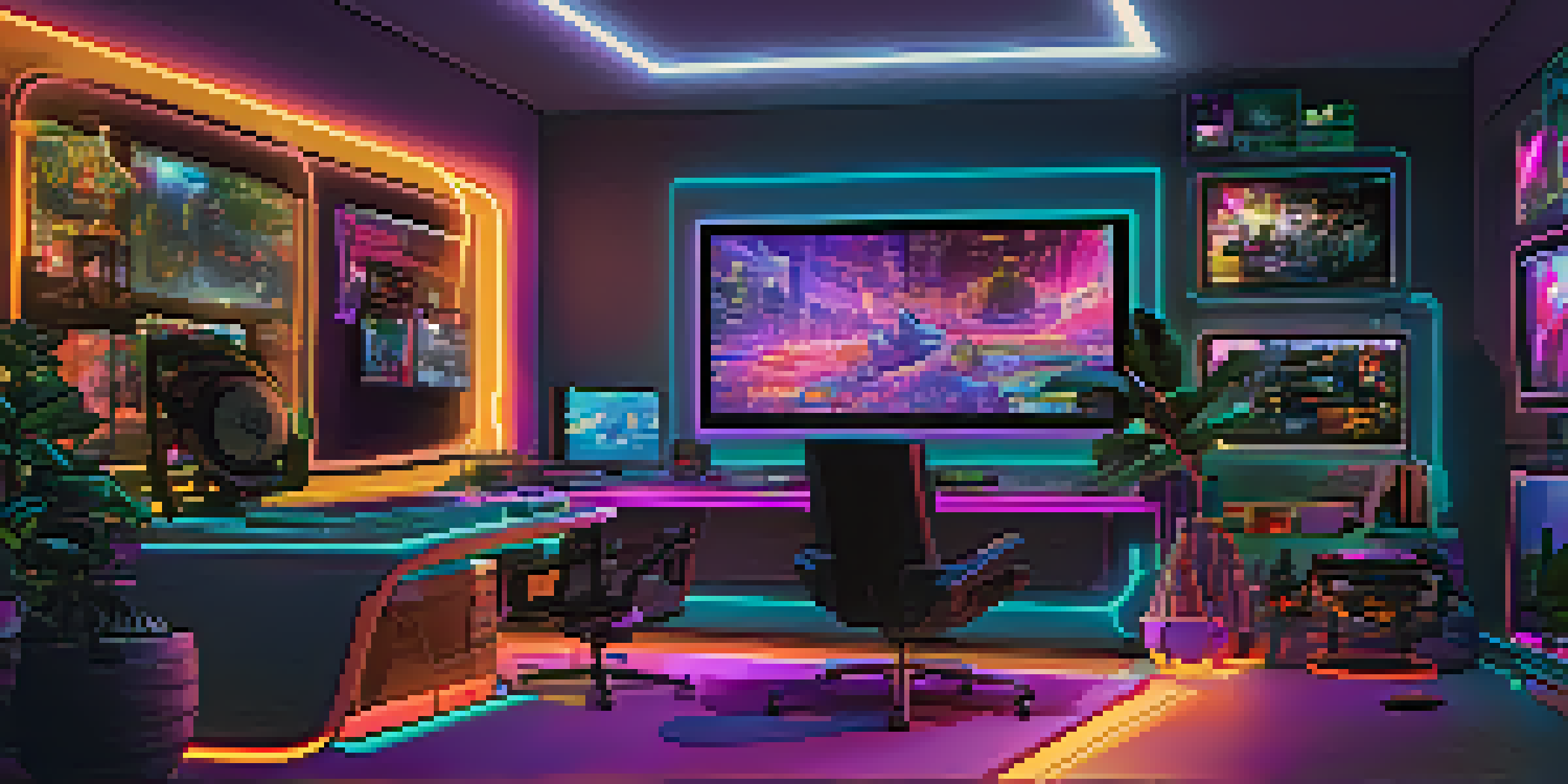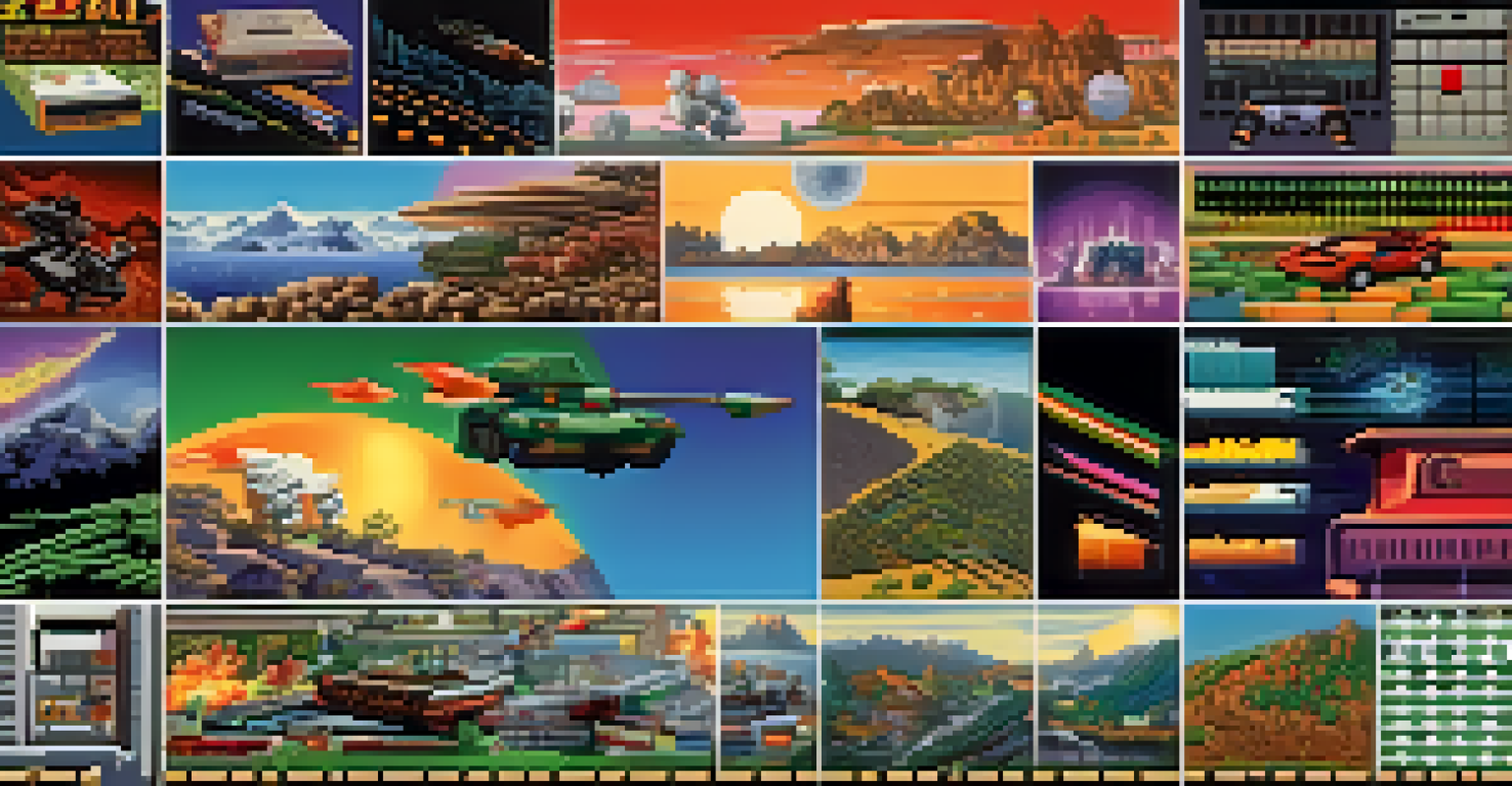The Evolution of Graphics Engines in Modern Gaming

The Birth of Graphics Engines: A Game Changer
Graphics engines have been pivotal in transforming gaming experiences since their inception. In the early days, games relied on simple 2D sprites and basic graphics rendering techniques, creating a pixelated world that was far from lifelike. As technology progressed, developers began to experiment with 3D graphics, leading to the creation of dedicated graphics engines that could handle the complexities of three-dimensional rendering. This marked the beginning of a new era in gaming, where visual storytelling became more immersive and engaging.
The graphics engine is the bridge between the imagination of the developer and the experience of the player.
One of the first major advancements came with the introduction of engines like Doom's id Tech 1, which utilized 3D ray casting to create a more dynamic environment. This engine allowed for intricate level designs and enemy interactions, capturing players' imaginations in ways previously thought impossible. As players began to expect more from their gaming experiences, developers responded by pushing the limits of what graphics engines could achieve, setting the stage for future innovations.
The evolution of graphics engines not only enhanced visual quality but also influenced gameplay mechanics. By providing developers with the tools to create richer environments, characters, and effects, these engines helped shape the overall gaming landscape. Today, we can see the direct impact of these early innovations in the stunning visuals and complex worlds that define modern gaming.
3D Graphics Engines: The Leap into Realism
As gaming technology advanced, so did the capabilities of 3D graphics engines. The introduction of hardware-accelerated graphics cards in the mid-1990s revolutionized how games were created and played. Engines such as Unreal Engine and Quake III Arena's engine harnessed the power of these graphics cards, delivering breathtaking visuals and smoother gameplay. This leap not only improved aesthetics but also allowed for more intricate gameplay mechanics and realistic physics.

Developers found themselves able to create vast, explorable worlds with detailed textures and dynamic lighting. Players could now interact with their environments in ways that felt more organic, such as realistic shadows that changed with the time of day or weather effects that influenced gameplay. This level of detail immersed players into the game’s universe, making every experience unique and engaging.
Graphics Engines Revolutionized Gaming
The evolution of graphics engines has transformed gaming from simple 2D visuals to immersive 3D experiences.
The shift towards realism also brought about new challenges for developers. Balancing graphical fidelity with performance became crucial, as not every player had access to the latest hardware. This led to the development of optimization techniques and scalable graphics settings, ensuring that games remained accessible to a broader audience while still delivering stunning visuals.
The Rise of Middleware: Simplifying Game Development
In the early 2000s, the gaming industry saw a significant rise in middleware solutions, which provided developers with ready-to-use graphics engines. These engines, such as Unity and CryEngine, made it easier for developers to focus on gameplay and storytelling rather than getting bogged down with complex graphics programming. This democratization of game development allowed indie developers and smaller studios to create visually impressive games without needing extensive technical expertise.
Technology is best when it brings people together.
Middleware engines often came with extensive libraries of assets and tools, enabling rapid prototyping and iteration. Developers could quickly test ideas, refine mechanics, and bring their visions to life without starting from scratch. This accessibility led to an explosion of creativity within the gaming community, as more voices and perspectives found their way into the industry.
Moreover, the rise of middleware contributed to the diversification of gaming genres and styles. From stylized indie games to hyper-realistic AAA titles, the variety of available engines allowed developers to experiment and innovate, resulting in a rich tapestry of gaming experiences that appealed to a wide audience.
Pushing Boundaries: Ray Tracing and Real-Time Graphics
As we ventured into the 2020s, the introduction of ray tracing technology marked a significant milestone in graphics engines. This technique simulates the way light interacts with objects in a realistic manner, creating lifelike reflections, shadows, and lighting. Graphics engines that support ray tracing, such as Unreal Engine 5, are capable of delivering visuals that blur the line between gaming and reality, making environments feel more immersive than ever.
Ray tracing doesn't just enhance visual fidelity; it also fundamentally changes how developers approach game design. The ability to create dynamic lighting and realistic reflections can influence gameplay mechanics and level design, as players navigate environments that respond to their actions in real time. This technology opens up new possibilities for storytelling and interaction, allowing developers to craft experiences that feel more alive and responsive.
AI Enhances Game Development
Artificial intelligence is streamlining various aspects of game design, allowing for richer visuals and more responsive gameplay.
However, the adoption of ray tracing also brings challenges. The processing power required for real-time ray tracing can strain hardware, demanding higher specifications from players’ systems. Developers must balance the desire for stunning visuals with the need for accessible gameplay, continuing the ongoing dance between technology and player experience.
The Role of AI in Shaping Graphics Engines
Artificial intelligence (AI) is playing an increasingly pivotal role in the evolution of graphics engines. By leveraging AI algorithms, developers can automate various processes, such as texture generation, character animations, and even gameplay balancing. This not only speeds up the development cycle but also enhances the overall quality of the gaming experience, allowing for more intricate details without overwhelming developers.
AI can assist in optimizing graphics performance by dynamically adjusting settings based on players' hardware capabilities. This means players can enjoy stunning visuals without needing the latest and greatest equipment. For instance, AI-driven upscaling techniques can enhance lower-resolution textures to look more detailed, giving players a better visual experience without the heavy performance cost.
Moreover, AI is being used to enhance in-game interactions, creating more lifelike non-player characters (NPCs) that respond intelligently to player actions. This level of sophistication adds depth to gameplay and enriches storytelling, as players engage with characters that feel more real and relatable. The integration of AI in graphics engines is a game changer, paving the way for innovative experiences in the gaming world.
The Future of Graphics Engines: What Lies Ahead?
Looking ahead, the future of graphics engines seems incredibly promising, with emerging technologies poised to redefine gaming experiences. Virtual reality (VR) and augmented reality (AR) are at the forefront, pushing the boundaries of immersion and interactivity. Graphics engines must adapt to these new mediums, providing developers with the tools needed to create compelling experiences that captivate players in entirely new ways.
Additionally, advancements in cloud gaming are set to change how graphics engines operate. By leveraging powerful cloud servers, developers can create visually rich experiences that aren't limited by players' hardware. This could democratize access to high-quality gaming, allowing anyone with an internet connection to enjoy breathtaking graphics without the need for expensive equipment.
Future of Gaming is Bright
Emerging technologies like VR, AR, and cloud gaming are set to redefine the capabilities of graphics engines and enhance player experiences.
As graphics engines continue to evolve, we can expect to see even more innovations that enhance realism and interactivity. The convergence of AI, VR, AR, and cloud technologies will likely shape the next generation of gaming, creating experiences that are not only visually stunning but also deeply engaging. The journey of graphics engines is far from over, and the possibilities are endless.
Conclusion: The Impact of Graphics Engines on Gaming Culture
In conclusion, the evolution of graphics engines has profoundly impacted the gaming industry and culture. From their humble beginnings with simple 2D graphics to the breathtaking realism of today’s titles, these engines have continually pushed the boundaries of what’s possible in gaming. They have not only enhanced visual quality but also enriched storytelling and gameplay mechanics, creating experiences that resonate with players on multiple levels.
Moreover, the accessibility of powerful graphics engines has democratized game development, allowing a diverse range of voices to contribute to the industry. This has led to a flourishing landscape of indie games and innovative concepts that challenge traditional norms, expanding what gaming can be. As more individuals find their creative outlet in game development, the future looks bright for the industry.

Ultimately, graphics engines are more than just tools; they are the backbone of the gaming experience. As technology continues to advance, we can only imagine the incredible journeys that lie ahead for gamers and developers alike. The evolution of graphics engines is a testament to the creativity and ingenuity of the gaming community, and it will undoubtedly continue to shape the future of entertainment.